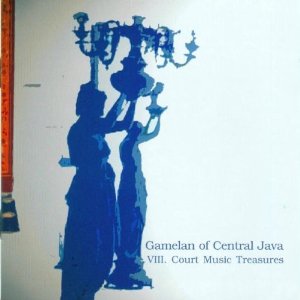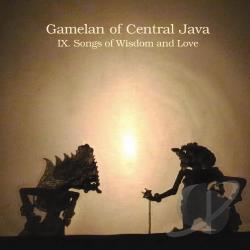 Volume VIII of the excellent and ongoing series of Central Javanese Gamelan produced by John Noise Manis is a pendant to the sixth volume, subtitled Kraton Surakarta. It represents an elaboration on the classical traditions of Javanese court music and, as Bapak Sumarsam points out in his essay, a transition into a new method of musical practice.
Volume VIII of the excellent and ongoing series of Central Javanese Gamelan produced by John Noise Manis is a pendant to the sixth volume, subtitled Kraton Surakarta. It represents an elaboration on the classical traditions of Javanese court music and, as Bapak Sumarsam points out in his essay, a transition into a new method of musical practice.
The musicians who performed on the previous CD and in an early LP from 1963 which features two pieces performed on this CD were traditional performers who had learned their art under the “old style” of musical pedagogy, i.e., they learned the gendings by ear and perfected them through repetition in both practice and performance (which in Indonesian music amounts to just about the same thing). Musical notation was, at that time, exceedingly rare. Those performing on the present disc are largely faculty from the Institute of the Arts in Solo. (If the name dimly rings a bell, ask your favorite paleoanthropology geek about Solo man, although, while the musical traditions of Indonesia are old, I make no claim for their being that old.) The current generation of performers habitually use musical notation and it has been an integral part of their own education as well as their teaching. I should point out that according to Sumarsam, notation even at this point plays nowhere near the role it does in Western music: in general, only the melodic skeleton is notated, and while individual vocal and instrumental parts may be written, these are used only by the performers in learning. If you’ve been following the discussion of musical practice in Indonesia, it probably will be no surprise that format in notation is a matter of individual preference.
There is a difference in the final product, although I don’t claim enough sophistication in Indonesian music to be able to spot it consistently. Sumarsam lays claim to the older tradition being somewhat richer, more spontaneous, and more prone to improvisatory asides, while the contemporary practice is more polished — more “finished,” as it were — and more precise.
In terms of listening, while I’ve managed to train my ear to identify the layers of sound in a gamelan performance, I still had to make an adjustment — to the vocal parts. The intervals are off and, initially at least, I couldn’t find a reference point. I seem to have made that transition, to the extent that I can see in the beginning of gending “Gambirsawit” the degree to which vocal soloists become an integral part of the ensemble. That piece is perhaps a prime example of Javanese court music at its height: sophisticated, tremendously evocative, astonishingly intense in places, it provides a perfect beginning to a sequence that builds a vivid image of an ancient culture and its artistic expression. This is a very intelligently structured collection, containing some extraordinarily beautiful music.
 Volume IX, Songs of Wisdom and Love, is a selection of sung poetry, both accompanied and unaccompanied. Sumarsam notes that the first track, “Kodhok Ngorek,” presents something new in the gamelan canon: it is a combination of new and old elements in a further progression of the ancient tradition. The title of the piece is deceptive: Kodhok Ngorek is an instrumental ensemble of quite ancient standing and gives no hint that the work contains sung poetry. The artists have combined this ancient ensemble with a song of the type known as macapat. The macapat takes up the bulk of the disc, both in the original style of monophonic, unpulsed solo and the style displayed in the first part of the first track, a pulsed song accompanied by instruments that not only support the melody but become markers in the structure, which is to say rhythmic elements.
Volume IX, Songs of Wisdom and Love, is a selection of sung poetry, both accompanied and unaccompanied. Sumarsam notes that the first track, “Kodhok Ngorek,” presents something new in the gamelan canon: it is a combination of new and old elements in a further progression of the ancient tradition. The title of the piece is deceptive: Kodhok Ngorek is an instrumental ensemble of quite ancient standing and gives no hint that the work contains sung poetry. The artists have combined this ancient ensemble with a song of the type known as macapat. The macapat takes up the bulk of the disc, both in the original style of monophonic, unpulsed solo and the style displayed in the first part of the first track, a pulsed song accompanied by instruments that not only support the melody but become markers in the structure, which is to say rhythmic elements.
Now that I’ve made the adjustment necessary to actually hear the vocals, this is quite an amazing group of songs. One thing that struck me was the dual sense of completion and anticipation at the end of each selection, as though a large cycle had completed a stage and I was waiting for the next stage to begin, which it did in due time. The differing methods of these songs, particularly the macapan in both traditional and “modern,” pulsed forms, generated a low-key tension that helped drive the disc. The final tracks present various forms of vocal interludes and “introductions” performed by vocal soloists, generally as part of a larger performance, ending with an example of gending kemanak, “Duradasih, which makes use of both scale systems, the pelog (heptatonic) and the slendro (pentatonic), as well as two rhythmic/melodic structures. It’s quite an amazing work, stately and reflective, and provides a satisfying conclusion.
Sumarsam includes a comment on the trials of translating from Old Javanese into modern English that aptly describes the difficulties for a Westerner (and an apprentice, at that) in commenting on Javanese music, or the music of the East in general: defining the meaning of Javanese words is like aiming at a moving target. That describes it perfectly, except not only is the target moving, it seems to be moving in more than one direction at a time. Nevertheless, I think for anyone interested in non-Western musical traditions, or just interested in hearing some beautiful music that is out of the ordinary, these latest two volumes add another layer of interest to a “must have” series.
Volume X of this series is reviewed here.
(Both Felmay, 2007)
